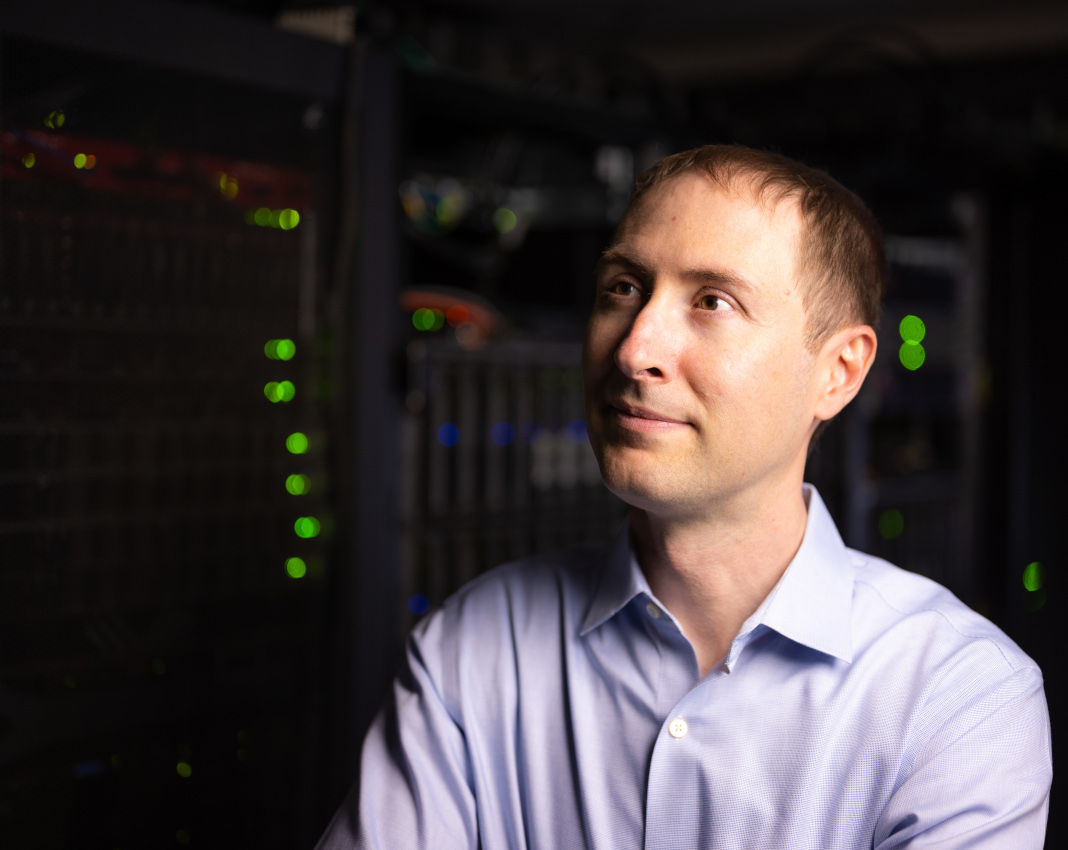Great Scott! The Falcon Supercomputer Is Fast!
Unraveling the Mysteries of Black Holes and Gravitational Waves
It can take months or longer to solve the enormous equations that provide new insights into black holes — those spinning vortexes in space from which even light cannot escape.
A computer that makes short work of sophisticated mathematics, unraveling the data of gravitational forces and ripples in space-time, and providing insights into the evolution of the universe, would be a groundbreaking scientific tool.
Zach Etienne knows of just such a computer, and the University of Idaho physics professor uses it regularly in his simulations of black holes.
Falcon, the supercomputer that is more than 10 times the processing power of any academic computer bank in the region, accommodates research at Idaho’s colleges and universities. U of I is one of three universities that gained access to Falcon a year ago, and faculty, as well as staff and student researchers, are welcome to tap its processing power.
Black Hole Collision Simulations
“Through the study of gravitational waves — ripples in gravity that emanate from black hole collisions — scientists have achieved exciting advancements in understanding the universe,” Etienne said. “To learn more about the black holes the actual gravitational waves are compared with theoretical predictions. These predictions rely on and are calibrated against supercomputer simulations of black hole collisions.”
Etienne tests software he developed to run black hole collision simulations on the Falcon supercomputer. He needs to improve the software's accuracy and robustness before launching a new citizen-science project he calls BlackHoles@Home.
The initiative would allow anyone to download the software and, for the first time, run black hole collision simulations on their desktop computers, contributing to the advancement of gravitational wave science.
“Having the Falcon supercomputer dedicated to academic and scientific research within Idaho is a tremendous asset, and it’s something we can take great pride in,” Etienne said. “I'm incredibly grateful for its availability.”
Zachariah Etienne
Associate Professor
Engineering-Physics 333
208-885-1220
Research: Numerical Relativity and Gravitational Waveastrophysics View Zachariah Etienne's profile
A High-Performance Facility
Housed at the Idaho National Laboratory (INL) Collaborative Computing Center, a high-performance computing facility that supports research at INL and Idaho public universities, the Falcon supercomputer is managed and operated by an agreement between INL, U of I, Boise State University and Idaho State University. U of I leads the partnership responsible for the management and upkeep of Falcon.
“Having this incredible asset available for use by our universities is an invaluable addition to the collaborative research capabilities of Idaho’s public universities,” according to the agreement between the universities and Battelle Energy Alliance, which manages INL.
When it was initially deployed in 2014, Falcon was ranked 97th on the list of the world’s fastest supercomputers. It was upgraded in 2017 and can now perform one quadrillion calculations per second. Falcon represents an order of magnitude increase in computing power for researchers at Idaho public universities.
“The Falcon supercomputer puts Idaho academic high-performance computing on the map, significantly increasing the attractiveness and competitiveness of Idaho’s research universities and the students and faculty they serve,” said Christopher Nomura, U of I’s vice president for research and economic development.
In addition to accelerating research and increasing opportunities for partnerships, this resource will help fulfill the mission of INL’s Center for Advanced Energy Studies to train and educate the future energy workforce.
Connecting the State’s Universities
Falcon is connected to the universities via the Idaho Regional Optical Network, which enables high-speed data transfers to both local and remote computing centers.
“[The] Falcon supercomputer … is a tremendous asset.”
— Zach Etienne, Associate Professor
“At the University of Idaho, computer modeling of complex problems is an expertise of our faculty and researchers,” Nomura said. “Having access to the Falcon supercomputer allows Idaho researchers to run larger simulations and analyses more than 10 times faster than previously possible and is a major game changer in our capability and capacity. This acceleration enables investigators to efficiently probe deeper and see farther, leading to new research advancements and insights.”
The supercomputer has nearly 35,000 total cores — or processors — available, with 972 compute nodes (responsible for volatile memory (RAM), permanent disk space and accelerators) each containing 36 cores and 128 GB RAM. This gives the system a theoretical peak of 1.17 Petaflops (1.17 x 1015 floating point calculations per second). Common processors can handle a gigaflop, and a petaflop is the equivalent of a million of these. A new high-speed network file system with 1.3 petabytes of usable capacity was purchased by U of I to support Falcon.
For more information about Falcon and to request an account,
visit c3plus3.org/falcon.

Article by Ralph Bartholdt, University Communications.
Photo by Joe Pallen, University Visual Productions.
Published in April 2023.








